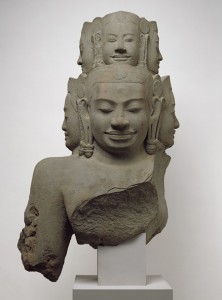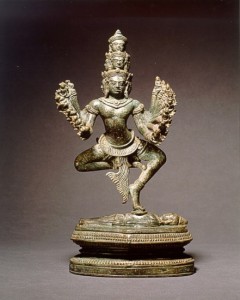 In 1925, French archaeologists excavating near the East Gate of Ankor Tom (the final great monument built in the Angkor complex of Cambodia) found a 900-year-old intricately carved bust of a 7-headed Buddha.
In 1925, French archaeologists excavating near the East Gate of Ankor Tom (the final great monument built in the Angkor complex of Cambodia) found a 900-year-old intricately carved bust of a 7-headed Buddha.
It was missing a head on top, its feet and arms, but the bust indicated it had once been a 10-foot statue of Hevajra, a warrior tantric deity often depicted with 8 arms on each side with feet in a dancing posture.
 The bust was sold to the Metropolitan Museum of Art in New York City, where it remains on display to this day. Nobody has found the remaining parts of the colossus, until Dr. Peter Sharrock took a break from a conference to hike the jungles around Ankor.
The bust was sold to the Metropolitan Museum of Art in New York City, where it remains on display to this day. Nobody has found the remaining parts of the colossus, until Dr. Peter Sharrock took a break from a conference to hike the jungles around Ankor.
All he had to make his way was a single old picture of the 1925 exhibition and a strong groin.
“There was no road, only a sort of animal track into the forest,” he said. “It was pretty unpleasant. There were snakes all over the place, and in the back of my mind was the knowledge that the Khmer Rouge had planted land mines all over Angkor.
“We went on and on, and were about to give up, when finally I spotted something through the trees. We strode through the creepers and thorns, and I realised that I’d seen the carved square corner of the statue’s pedestal. And lo and behold, there were the legs lying beside it.” […]
Hevajra would have been venerated during the reign of Jayavarman VII, emperor of the Khmers at the height of their power, but it is likely the statue was broken up and dumped outside the city walls during a revival of Hinduism in the 14th century. This theory undermines the view that the Khmers followed a compassionate Buddhist philosophy. “It’s something of a tectonic shift in archaeology”, Dr Sharrock said.
The legs are not in supergreat condition, judging from the picture. I’m not seeing much detail in the carving. Perhaps once some conservation is done and the greenery is removed we’ll be able to see more.
The Cambodian government has pledged to excavate the area further in search of the rest of the statue, so keep your 80 fingers crossed.
It is a great thing to share photos of ancient / historical treasured findings. There is a great interest in viewing them along with study. I personally find that most scientific web/ sites do very little to illustrate artifacts, discoveries and what photos are used fail in detail, quantity and quality…with modern photo equipment such as an ‘over-the-counter’ canon digital and ‘photo-shop’, photos are transformed into works of art and assist in presentation..There is interest and that data is worth the reading from scientific papers yet detailed photo study are almost never available, this would make one surmise that the scientific community discourages an interests in historic and ancient art and artifacts as a possible ‘looting’ scenario. Too many regulations and discouraged behavior in field, will and does distract from cooperation from non-scientist sector…
Pictures can usually be found. In this day and age, entire archaeological projects can be put online, complete with Flickr accounts full of pictures.
You just have to look around a little bit, because the local media who often carry stories of historical import don’t always include an expensive wire service picture.
Fantastic piece. Buddhist antiquities have always held a special appeal to me. Laos has treasures yet to be discovered, I’m sure.
Oh, indeed. I would say conservation is more of a priority than discovery right now, especially in inimical climates. Then there’s the whole land mine issue…
:ohnoes: Those legs look like a rock. The base in the background is looking pretty good; though whether that’s the base for this same piece is unclear to me, as there seems to be something square(-ish) in the bottom left of the pic that matches the condition of the legs much more than the one in the back. But that could actually be a rock. Like a real rock, not the leg-rock. 😆
I have stared at that picture every which way and I can safely claim that I have no idea what the hell is going on with that rock. Is that a bended knee on the right? No idea.
:yes:I like it.i’m very happy.i know you study about khmer :thanks:
I am scepotical about this entire thing, even while I was reading the article and before I actually looked at the picture.
So some guy from some museum who happens to know about this statue goes to Khmer and wanders through the woods, taking a random “animal track” into the middle of the wilderness…all the while afraid of snakes and land mines….then just “happens” to run across the legs of the statue and knows exactly what it is?
Looking at the picture, it looks like just a rock to me.
Of course, this could actually be legitimate, but my skepticism sensors are ringing here. It doesn’t look much like a leg to me. Of course, it could be eroded down from laying in the woods for centuries, losing much of the finer detail. But still, I am not very well convinced…..
The picture appears to show the legs from below,so what can mostly be seen is where the lower legs have been broken off. The right knee is top left, and the left knee is to the right. The piece is actually lying on its bottom, and you can just see part of the right cheek, at the lower end of the vertical section, in a depression in the soil.
If that is the base for the statue, presumably the rock on top of it must be the toes of the left foot.